2022.02.12
The Future Standard for Corporate Learning: Implementing the ‘Learning Ecosystem’ to Maximize ROI in Talent Development
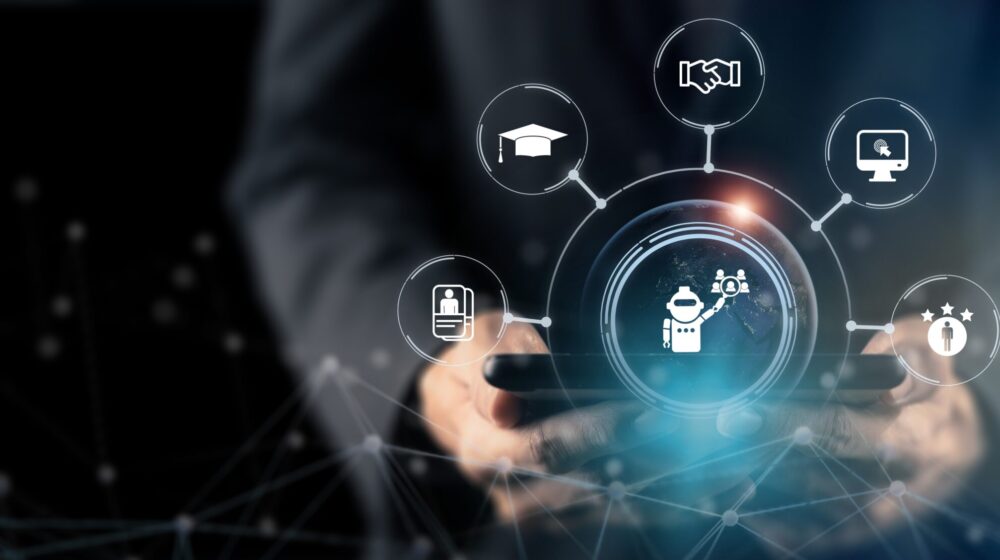
Just as ‘Strategic HR’ has become a key focus, learning is now more critical than ever for maintaining a company’s competitive edge.
While many executives recognize the importance of developing employees with the right skills, common challenges persist, such as:
‘Despite offering free training, employees do not engage with it.’
‘Few employees maintain a consistent learning habit.’
While hiring external talent to bridge skill gaps is an option, it has limitations—especially when the required skills are not readily available. In the end, the best solution is to strengthen internal learning, but this requires addressing a critical challenge: transforming ‘knowing’ into ‘doing.’
Traditional corporate training alone is insufficient to bridge this gap. This is where the concept of a Learning Ecosystem comes into play.
In this article, we will explain the Learning Ecosystem—a fundamental concept for the modern role of corporate learning professionals.
1. Strategic HR and the Evolving Role of Learning Professionals
If you work in talent development, you’ve likely heard the term Strategic HR, which stands for Strategic Human Resources Management (SHRM)—an approach that aligns human resource management with business strategy.
A learning professional’s role involves designing and implementing workforce development strategies. Within this, learning plays a pivotal role.
Corporate learning serves four essential functions:
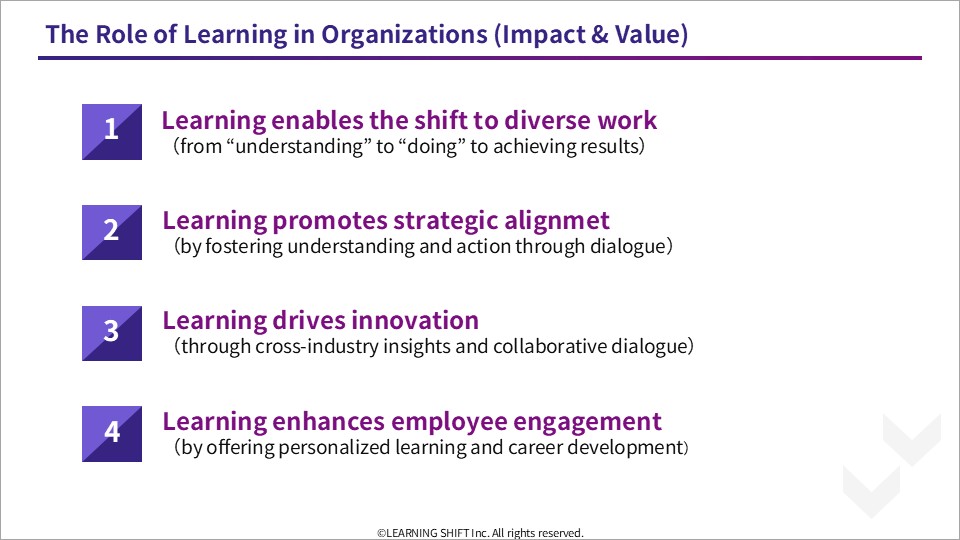
When we take a closer look, the potential impact of learning is limitless— the more you invest in it, the more it can be expected to drive tangible results.
However, not many organizations fully understand the true role of learning, nor do they implement it to its full potential.
While an increasing number of companies are shifting toward digitalizing corporate learning under the goal of talent development for achieving business objectives, this alone is not enough to fulfill the aspirations of strategic HR. The reason is that simply adopting technology does not solve the long-standing issues inherent in traditional learning models.
Traditionally, “learning” has referred to training conducted during formal programs. Many organizations may have dedicated significant time and effort to running these scheduled training sessions listed in their annual calendars. Yet, this only represents a small part of the broader picture of corporate learning.
Learning doesn’t only happen during formal training sessions. With workforce diversity and decentralization on the rise—and the COVID-19 pandemic accelerating the spread of remote work—opportunities for in-person communication have declined. As a result, certain forms of learning that rely on intentional interaction, such as dialogue, have become less common. This is where informal learning comes into play.
When we investigate where people actually learn, it turns out that self-directed learning occupies a far greater portion than formal training provided by HR or learning professionals.
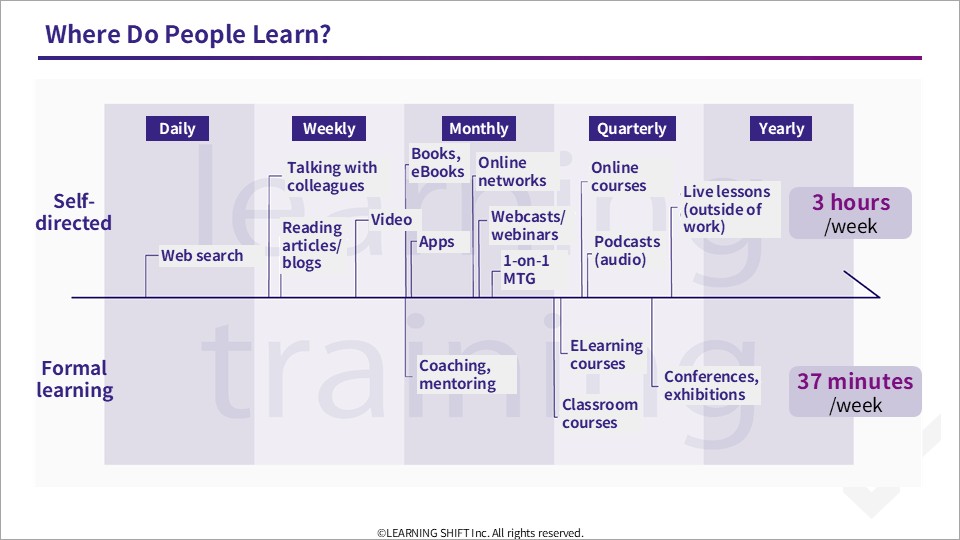
Historically, corporate learning has focused heavily on formal training sessions—workshops and scheduled courses. However, research by Lominger has shown that only 10% of effective learning occurs through formal training. The remaining 90% comes from:
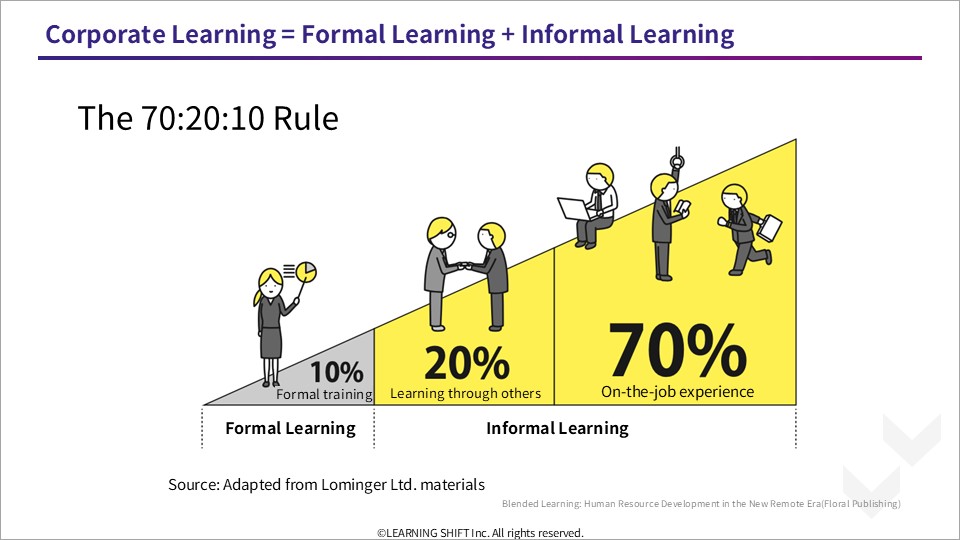
From this, we can see that informal learning is an essential element in future learning design.
At the same time, learning and development professionals are now expected to have the ability to comprehensively produce both formal and informal learning.
To put it more concretely, regardless of whether it is “formal” or “informal,” it is now essential to place more emphasis on “Performance Learning”—a learning design that guides learners from “understanding” to “doing.”
In traditional training, the typical style was for learners to acquire new knowledge and skills from instructors.
However, from the perspective of “learning that leads to results,” just “knowing” is not enough.
It is only when someone can actually “do” something that we can say they have truly “learned.”
Performance Learning is a learning method that places importance on the ability to “do” and focuses heavily on practice.
Specific examples of practice include:
- Expressing one’s own opinion
- Taking a test
- Teaching someone else
Performance Learning is characterized by repeated practice and feedback involving these kinds of tasks, allowing learners to go through trial and error until they are able to perform.
From this, we can say that the new role of learning professionals is to create learning environments centered around the workplace and develop the talent needed to achieve business goals.
In order to realize such learning within the organization, learning professionals would have to walk around the office every day to check on learning progress—something that is not very realistic.
That is why the next step is to build a learning ecosystem using technology, which will be introduced in the following section.
2. What is a Learning Ecosystem?
A Learning Ecosystem is a framework that integrates various learning experiences—formal training, informal learning, and workplace experimentation—into a continuous cycle of growth.
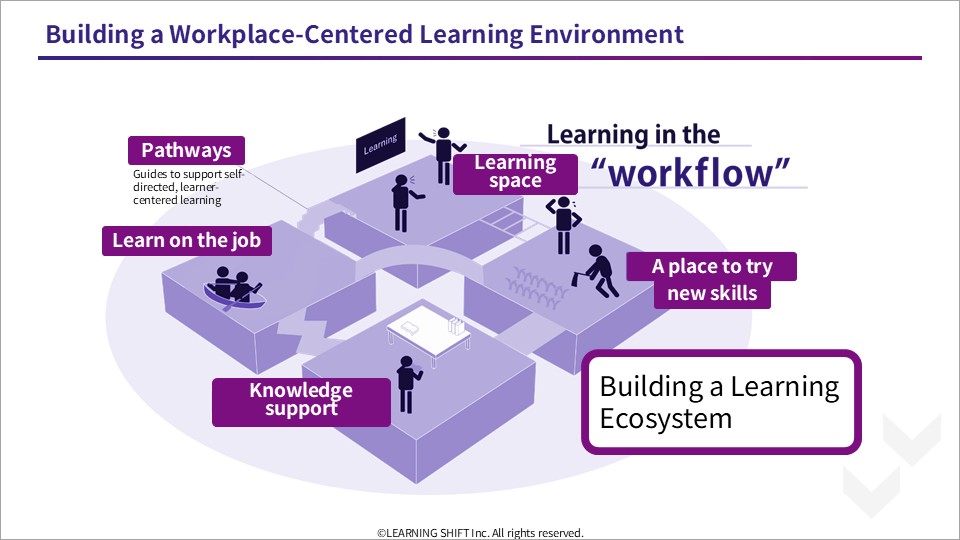
This learning ecosystem is composed of learners and the people around them—both inside and outside the organization—as well as content and technology.
The Five Key Components of a Learning Ecosystem
#1.Learning Spaces (Gardeners)
#2.Practice Environments (Hothouses)
#3.On-the-Job Learning (Streams)
#4.Knowledge Support (Foundations)
#5.Guided Learning Pathways (Pathway)
各要素について見てみましょう。
#1.Learning Spaces
These are spaces where employees learn from others—for example, by hearing new perspectives or organizational policies. Examples include training programs, online discussions, team dialogues, or shared work sessions.
Here, learning is not one-way; learners engage in mutual learning with others present.
#2.Practice Environments
Once knowledge and skills are acquired in learning spaces, they need to be practiced. These are the spaces where learners test and apply what they’ve learned.
#3.On-the-Job Learning
Ideally, employees gain necessary knowledge before starting a new task—but sometimes, learning must happen during the job itself. Talent development professionals should create systems that support learning as part of the workflow.
#4.Knowledge Support
In this area, it’s essential to prepare content that supports learners. Since creating all materials from scratch is unrealistic, it’s also important to curate and edit existing resources in addition to developing original content.
#5.Guided Learning Pathways
This serves as a guide to help learners choose effective methods and tools to move from “understanding” to “doing” as efficiently as possible.
They can practice new skills, receive feedback, and take an active role in their own learning.
A key benefit of a learning ecosystem is that anyone—not just instructors—can become a source of learning.
It enables a shift from one-way instruction to mutual learning.
While traditional corporate learning often relied on top-down teaching, learning ecosystems emphasize collaboration and peer learning.
They also integrate formal and informal learning naturally, allowing learners to study comfortably and efficiently.
3. The Importance of a Learning Ecosystem
A Learning Ecosystem fosters a culture of continuous learning by:

As shown in the diagram above, a learning ecosystem places the learner at the center of the learning experience.
In this Learning Experience Design (LxD), the following elements are provided to support learners:
- ① Learning Contents: Learners receive the content they need to build knowledge and skills.
- ② Social Support: Through the content, opportunities for discussion and peer interaction—such as talking with colleagues or supervisors—naturally occur.
- ③ Learning Environment: The environment gradually develops to support learning through mutual exchange, peer learning, and constructive feedback.
When implemented effectively, a Learning Ecosystem becomes embedded in an organization’s DNA, shifting learning from a top-down directive to a self-sustaining culture of knowledge exchange.
4. Key Components of a Learning Platform for a Learning Ecosystem
To support a Learning Ecosystem, organizations must invest in a Learning Platform that integrates various technologies and tools. Key requirements include:
#2.Performance Learning
・Supports the full learning cycle, from understanding to doing
・Enables learning design that drives outcomes such as mindset shifts and behavior change
#2.Blended Learning
・Combines three learning modes: in-person, online training, and self-paced e-learning
・Offers diverse learning formats, including online/offline, synchronous/asynchronous, and one-way/interactive
#3.Curation
・Allows easy content creation by administrators
・Centralizes and organizes all types of content
・Utilizes both internal and external content sources
#4.Microlearning
・Empowers all employees to be both learners and contributors
・Provides easy access to the right learning at the right time
・Enables frontline employees to create, edit, and distribute content with ease
#5.Informal Learning
・Covers not only formal training but also daily learning experiences
・Enables sharing, interaction, and publishing of day-to-day knowledge
・Supports AI-driven content recommendations
#6.Learning Management
・Allows centralized management of all learning activities—including course enrollment, completion, practice, and assessments—while enabling a data-driven PDCA (Plan–Do–Check–Act) cycle.
In addition to features #1 through #6, an ideal learning platform should also offer high usability and versatility for learners, instructors, and HR personnel.
5. まとめ
A successful Learning Ecosystem comprises five elements:
#1.Learning Spaces
#2.Practice Environments
#3.On-the-Job Learning
#4.Knowledge Support
#5.Guided Learning Pathways
A robust Learning Platform supports these elements, ensuring that employees have access to the right learning at the right time.
To cultivate a culture of continuous learning and enhance ROI in talent development, companies must shift from a traditional training model to a Learning Ecosystem—where employees are empowered to learn, practice, and grow every day.